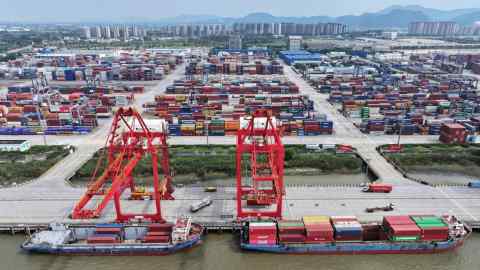
It’s no longer a given that China will become the world’s largest economy

 The primary policy question now is how quickly China will shift away from stimulus measures to a faster fundamental overhaul of its growth strategy © AFP via Getty Images
The primary policy question now is how quickly China will shift away from stimulus measures to a faster fundamental overhaul of its growth strategy © AFP via Getty Images We’ll send you a myFT Daily Digest email rounding up the latest Chinese economy news every morning.
The writer is president of Queens’ College, Cambridge, and an adviser to Allianz and Gramercy
Economists and Wall Street analysts have been disappointed in China’s economic performance, holding out hope that this might prompt the government into a stimulus effort similar to the one seen in 2008.
This, in turn, would reinvigorate domestic growth and restore China as a key engine of global expansion. However, the more likely scenario is continued weak growth. The primary policy question now is how quickly the government will shift away from stimulus measures to a faster fundamental overhaul of its growth strategy.
China’s underwhelming economic performance so far in 2023 can be attributed to two major factors: a lacklustre recovery following the easing of stringent zero-Covid restrictions, and more persistent and structural growth challenges. The latter is the result of an economic strategy that has historically over-relied on real estate, high local debt, inefficient state-owned enterprises, lower-end manufacturing, and domestic consumer internet platforms.
This problem has been exacerbated by several factors, including regulatory over-reach, ongoing geopolitical tensions and lower foreign direct investment inflows. There have also been concerns about a potential Japan-style deflationary trap, especially in light of declining consumer and producer prices. Some foreign investors have asked whether “China is investible”.
The Chinese authorities have announced over recent weeks a series of small monetary, fiscal, and regulatory measures to boost the economy and markets. These measures have thus far been perceived correctly as piecemeal and lacking conviction. Yet many still believe they will eventually accumulate into an impactful critical mass. There are problems, however, with this view.
China faces not only growth challenges but also significant financial issues, including pockets of high indebtedness that could easily transform into systemic risks. This limits the scope for old-fashioned stimulus. The heightened sensitivity surrounding the struggling property sector, in particular, makes households more cautious on spending, further diminishing a growth driver. Concerns about youth unemployment persist, and are not been helped by the government’s decision to halt the release of relevant data.
The external trade and investment outlook is equally problematic. There is a growing realisation that the economic and financial decoupling between China and the US is likely to continue. This could reduce the contribution of exports to growth, disrupt the importation of crucial industrial inputs, undermine foreign direct investment, and make portfolio investors even more skittish.
The willingness of the authorities is also in question. A careful analysis of the leadership’s statements points to worries that heavy reliance on traditional stimulus measures would jeopardise China’s ability to escape the common development trap of getting stuck in middle-income levels. This pitfall has already hindered many developing countries in their quest to join the ranks of advanced economies. A big-bang stimulus would also increase the risk of corruption.
Recommended
Chinese tradeChina’s renminbi hits 16-year low after exports tumble in August
It is likely authorities will continue to only tinker with small stimulus measures while seeking to communicate better their intention to accelerate the transition to new growth sectors (such as higher value-added manufacturing, green energy, healthcare, artificial intelligence, supercomputing, and life sciences). This revamped growth model takes time and involves creative destruction, especially in the short term. Additionally, the authorities will need to consider more forceful debt restructuring measures that, initially, also detract from growth.
It is time for the markets to recognise that China is not reverting to its old economic and financial playbook, and its return as a powerful driver of global economic growth is unlikely in the near future. Economic performance is likely to remain lacklustre for the remainder of 2023 and the first half of 2024.
Looking beyond this period, the outlook is also far from reassuring. The challenging process of reorienting the Chinese economy in the face of ongoing geopolitical tensions and the complexity of building an alternative international order poses significant hurdles. The authorities will also need to overcome their now overwhelming inclination towards centralisation and, instead, enable but not micromanage the emergence of powerful private sector engines of growth. Despite what many may continue to tell you, it is no longer a given that China will become the world’s largest economy.
{"contentId":"20a14331-d282-4039-97d2-71d777359733","brandConcept":"f021ef0a-e3a5-3530-9394-21a1eaf9f3f6","focus":["29e67a92-a3b8-410c-9139-15abe9b47e12","bf38d79f-556e-4f4e-885c-a9e67594140a","c91b1fad-1097-468b-be82-9a8ff717d54c","dd3cc5a2-d14b-4b78-811c-89c387497476","6da31a37-691f-4908-896f-2829ebe2309e","f021ef0a-e3a5-3530-9394-21a1eaf9f3f6","1b0e0dc0-21f2-4216-8c14-1204b0ae26d8","2c9058b4-369b-43db-a018-d1f8a4fe5a82","82645c31-4426-4ef5-99c9-9df6e0940c00","8b82f4f1-6fdf-4fe1-91db-99cac1802016","ec4ffdac-4f55-4b7a-b529-7d1e3e9f150c","fab33c6e-17a3-4c4b-b457-1c8e7aceff6d"],"authorConcepts":["ab6d1965-3354-4d9e-ad4d-a4486b027388"],"displayConcept":"bf38d79f-556e-4f4e-885c-a9e67594140a"}Copyright The Financial Times Limited 2023. All rights reserved.Reuse this content (opens in new window) CommentsJump to comments sectionPromoted Content Follow the topics in this article- Mohamed El-Erian Add to myFT
- Markets Insight Add to myFT
- Global Economy Add to myFT
- Chinese economy Add to myFT
- Markets Add to myFT
Owl Media Group takes pride in providing social-first platforms which equally benefit and facilitate engagement between businesses and consumers and creating much-needed balance to make conducting business, easier, safer, faster and better. The vision behind every platform in the Owl Media suite is to make lives better and foster a healthy environment in which parties can conduct business efficiently. Facilitating free and fair business relationships is crucial for any thriving economy and Owl Media bridges the gap and open doors for transparent and successful transacting. No advertising funds influence the functionality of our media platforms because we value authenticity and never compromise on quality no matter how lucrative the offers from advertisers may seem.
Originally posted on: https://www.ft.com/content/20a14331-d282-4039-97d2-71d777359733